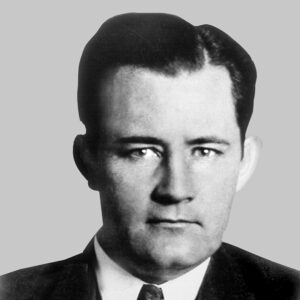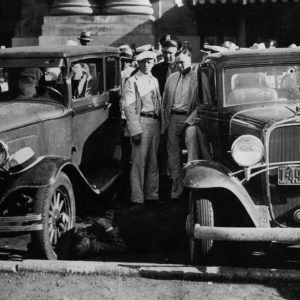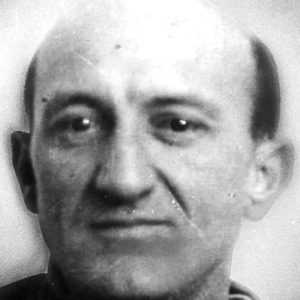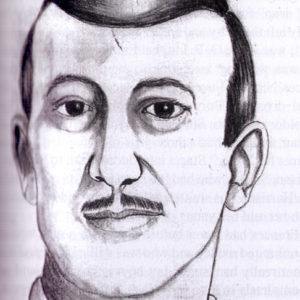calsfoundation@cals.org
Frank "Jelly" Nash (1887–1933)
Frank Nash has been called “the most successful bank robber in U.S. history,” but he is most noted for his violent death in what has become known as the Kansas City Massacre. Nash spent part of his childhood in Paragould (Greene County) and was arrested in Hot Springs (Garland County) the day before his death.
Frank “Jelly” Nash was born on February 6, 1887, in Birdseye, Indiana. His father, John “Pappy” Nash, started hotels in several southern towns, including Paragould, Jonesboro (Craighead County), and Hobart, Oklahoma. Nash’s mother, Alta, was the second of John’s three wives. Nash had two sisters and two step-brothers. Living in Paragould from 1893 to 1896, he then moved with his father to Jonesboro and, afterward, to Hobart, which he later treated as his hometown.
Nash worked in his father’s hotels and also served in the U.S. Army from 1904 to 1907. He later served three prison sentences for various crimes, including robbery and murder. Nash is thought to have participated in roughly 200 bank robberies and was often considered the “mastermind” of several groups of criminals. He planned various escapes from prison, both from within the prison and while free. In spite of his criminal record, Nash was widely considered friendly, likeable, and charming. His nickname, “Jelly” (shortened from “Jellybean”), began during his childhood, due to his poise and his well-groomed appearance (although some associate the nickname with the explosives used to open bank safes).
Nash was first convicted in 1913. He and a friend, Nollie “Humpy” Wortman, stole nearly $1,000 from a store in Sapulpa, Oklahoma. While escaping, Nash suggested they hide the evidence. As Wortman went to bury the money, Nash shot him in the back. He was arrested hours later and sentenced to life in the Oklahoma State Penitentiary. On March 28, 1918, Nash’s sentence was reduced to ten years after he convinced the warden he wanted to join the army and fight in World War I. Nash signed his military registration card on June 12, 1918, and was released on August 16, 1918. Nash saw action in Belleau Wood, France, before the end of the war.
Two years later, Nash was convicted of burglary using explosives, also known as safe-cracking, and sentenced to twenty-five years in the Oklahoma State Penitentiary. He became a trusty, and his sentence was reduced to five years. On December 29, 1922, Nash was released, and he joined the Al Spencer gang, a group of bank robbers.
On August 20, 1923, the Spencer gang robbed the Katy Limited postal train at Okesa, Oklahoma. Nash fled to Juarez, Mexico, where he married a local woman. Many sources claim that Nash hoped to falsify the date on the marriage license to provide him an alibi for the time of the train robbery. The same sources also state that Nash was already married to a sweetheart from Hobart, but the names of his first two wives are not known. His military registration card indicates that he was single in 1918.
Nash was enticed across the U.S./Mexico border and arrested for the burglary of the Katy Limited in early 1924. On March 1, Nash and three members of the Spencer gang received twenty-five-year sentences at the federal penitentiary at Fort Leavenworth, Kansas, for mail robbery and assault on a mail custodian. In 1930, Nash was appointed the deputy warden’s chef and general handyman, a position that brought privileges. On October 19, 1930, Nash was sent outside the prison on an errand and never returned.
Nash escaped to Chicago, Illinois, where he fell in love with a barmaid named Frances Luce and continued his criminal activities, now in the major cities of the United States. Among other crimes during these years, Nash assisted in the escape of seven prisoners from Fort Leavenworth in December 1931.
Nash visited Hot Springs with Frances Luce and her daughter in the spring of 1932 and returned with them the following spring. Hot Springs was then known as a playground for members of the criminal underworld. Without telling her about his first two wives, Nash married Luce on May 26, 1933. The two adopted the last name of Moore.
On June 15, 1933, two Oklahoma City Federal Bureau of Investigation (FBI) agents, Joe Lackey and Frank Smith, learned that Nash was in Hot Springs. The agents drove to Hot Springs accompanied by Otto Reed, the police captain of McAlester, Oklahoma, as FBI agents were forbidden from carrying weapons and making arrests. They learned that Nash was frequently found in the White Front Cigar Store, which was owned by Richard Galatas and frequented by many criminals of a national stature. On June 16, the agents apprehended Nash and drove to Fort Smith (Sebastian County).
That night, Nash, accompanied by Lackey, Smith, and Reed, boarded a Missouri Pacific train bound for Kansas City, Missouri. However, word of Nash’s capture had gotten around, as well as the destination of the agents, and plans were apparently made to attempt to free him. After arriving at the Kansas City Union Station at 7:15 a.m. on June 17, 1933, and meeting additional agents, Nash was put into a parked car outside the station. Two or three armed men approached the car, and many shots were exchanged. Accounts differ regarding who fired first. Nash was killed, as were Reed, Raymond Caffrey, W. J. “Red” Grooms, and Frank Hermanson. Based on the testimony of the surviving agents, authorities sought Charles “Pretty Boy” Floyd, Adam Richetti, and Vern Miller as suspects. Miller was later found murdered in Detroit. Floyd was killed in Ohio in October 1934. However, Richetti was arrested in Ohio, tried and convicted for the shootings, and executed on October 7, 1938.
The body of Nash was claimed by his sister, Alice Long, and is buried in Linwood Cemetery in Paragould. His funeral brought many strangers, assumed to be gangsters, to town. Prompted by the massacre, in January 1934, the U.S. Congress passed legislation that armed FBI agents and gave them the authority to make arrests.
For additional information:
Clayton, Merle. Union Station Massacre: The Shootout that Started the FBI’s War on Crime. Indianapolis: The Bobbs-Merrill Co., Inc., 1975.
“Frank Nash’s Paragould Relatives.” Greene County Historical and Genealogical Quarterly 11.1 (1998): 21–32.
“How Frank Nash Became Famous, Part 2: From the School of Crime to the ‘Big Time.’” Greene County Historical and Genealogical Quarterly 10.3 (1997): 101–115.
“How Frank Nash Became Famous, Part 3: From His Capture in Hot Springs to the Mausoleum in Linwood Cemetery.” Greene County Historical and Genealogical Quarterly 10.4 (1997): 141–158.
“How Paragould’s Frank Nash Became Nationally Famous, Part 1: From Paragould to Leavenworth.” Greene County Historical and Genealogical Quarterly 10.2 (1997): 39–61.
“Kansas City Massacre—Charles Arthur ‘Pretty Boy’ Floyd.” FBI History. Federal Bureau of Investigation. Online at https://www.fbi.gov/history/famous-cases/kansas-city-massacre-pretty-boy-floyd (accessed August 24, 2022).
Unger, Robert. The Union Station Massacre: The Original Sin of J. Edgar Hoover’s FBI. Kansas City: Andrews McMeel Publishing, 1997.
Kim Reynolds
Bryant, Arkansas
Staff of the CALS Encyclopedia of Arkansas
 Barker-Karpis Gang
Barker-Karpis Gang Early Twentieth Century, 1901 through 1940
Early Twentieth Century, 1901 through 1940 Raymond J. Caffrey
Raymond J. Caffrey  Floyd Wanted Poster
Floyd Wanted Poster  Kansas City Massacre
Kansas City Massacre  Frank Nash
Frank Nash  Frank Nash Police Sketch
Frank Nash Police Sketch  Adam Richetti
Adam Richetti 




Comments
No comments on this entry yet.